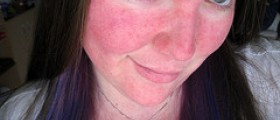
Rosacea is a dermatologic condition that affects the mid-facial region; nose, cheeks, forehead, chin and glabellas. More than half of all patients with rosacea develop ocular rosacea at some point in time. Ocular rosacea is inflammation of the eye that results from rosacea. Sometimes ocular rosacea develops without any other skin symptoms.
This health condition is most frequent in patients between the ages of 30 and 60, especially if they have fair skin and light hair and eye color. People with rosacea should have their eyes checked by an eye doctor as in many cases they fail to recognize ocular rosacea symptoms.
Symptoms of ocular rosacea
Signs and symptoms of ocular rosacea can sometimes precede skin symptoms, develop at the same time, or develop later. In almost 20 percent of all cases, ocular rosacea develops on its own. Usually, patients with ocular rosacea are more dehydrated than normal or than facial rosacea patients.
This causes various unpleasant symptoms such as burning or stinging of the eyes or sensitivity to light, visible broken capillaries on the eyelid, persistent conjunctivitis and redness around the eyes. Although the manifestations of rosacea are usually non-specific, and usually mistaken for seasonal allergies, patients should seek medical help if they feel dry eyes or eyes which feel sandy or invaded by a foreign body, inflamed or dry/flaking eyelids, eyelash loss, inflammation of the eye-whites, and inflammation of the iris or visual dysfunction.
Causes of ocular rosacea
Scientists are not really sure about what exactly causes ocular rosacea. Most probably, this condition develops as a result of numerous factors, especially hereditary and environmental ones. Normally, factors known to aggravate rosacea can make the ocular rosacea worse, as well. These factors include: eating spicy foods, drinking alcohol, being at extreme cold or heat, being in sunlight, vigorous exercise, high levels of stress, enjoying hot baths or being at steam rooms or saunas, taking corticosteroids, or certain medications, namely blood pressure medications.
In some cases, ocular rosacea may be caused by anti-wrinkle creams or make-up. Anti-wrinkle creams may contain extremely harsh and aggressive compounds that may cause the inflammation to the eye and eyelids. Ocular rosacea resulting from make-up often occurs because of the bacterial growth from the make-up applicator.
Treatment of ocular rosacea
There is no known cure for ocular rosacea but the aim of successful therapy is to manage the symptoms of the condition. Therapy usually involves prescribed oral antibiotics, the temporary use of oral corticosteroids to reduce inflammation and frequent use of artificial tears.

















Your thoughts on this
Loading...